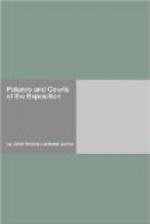As you stand by the Pool, notice the shrubs and flowers near by.
Near the columns are Monterey cypresses.
Grey-green artemisia is between the columns.
Ten thousand periwinkles are on the banks.
Five thousand Spanish iris.
Many Japanese iris.
California incense shrub.
Yellow primroses.
One thousand white callas.
One thousand yellow callas.
One thousand California violets.
The shiny-leaved coprosma from Chili.
Blue-flowered buddleia.
Groups of pittosporum.
Pampas grass from Brazil.
Hundreds of daffodils (in March).
The weeping willows.
A great group on the north of erica, epacris, and cryptomeria.
Across from the erica is the red-berried cotoneaster horizontalis.
Near the columns on the north side by the Pool grows the purple agapanthus.
The Catalina cherry is massed against the building on the north.
The pink-flowered escallonia is found under the columns near the Pool. The orange-berried pyracantha cretaegus is seen in all its glory on the north.
Heliotrope makes the air one of sweet perfume. Polygala, with pea-like blossom, is seen near the base of the columns.
In the Pool have been put five hundred papyrus plants and five hundred Japanese water lilies.
These are a few of the many wonderful blooms seen here.
The vistas and reflections are ever new and beautiful from every turn of the Pool.
Palace of Horticulture
Architects — Bakewell and Brown of San Francisco.
Architecture — Byzantine in the arrangement of the domes (the mosque of Ahmed I of Constantinople being the inspiration) and in the use of tall finials suggesting minarets, but quite French in its ornamentation.
The building is one of great beauty and is considered one of the finest exhibit palaces ever erected at any exposition.
The ornamentation below the dome is by Boutier.
The Caryatids of the Caryatid Porch are by John Bateman of New York.
The great opulence of the harvests of California is brought to mind by the lavish abundance of the ornamentation on this building.
The combination of the smoked-ivory color of the travertine and the lattice green of the decorations produces a more lovely effect.
The basket atop is over thirty-three feet in diameter.
The dome is 152 feet in diameter. St. Peter’s
dome is 137 feet; the
Pantheon dome is 142 feet.
Under the dome will be a constant display of hothouse plants. At the opening of the Exposition were seen cinerarias and cyclamen of glorious hue.
A wonderful display of orchids is seen in another portion of this great building.
Those interested in orange packing will have a chance to see the different stages of the packing as shown from the arrival of the fruit at the packinghouse to the nailing of the cover on the box.




